https://sputnikglobe.com/20230501/astronomers-spot-black-hole-devouring-a-star-1110010274.html
Astronomers Spot Black Hole Devouring a Star
Astronomers Spot Black Hole Devouring a Star
Sputnik International
Astronomers from the Massachusetts Institute of Technology (MIT) have detected a rare space phenomenon that occurs when a supermassive black hole consumes a star.
2023-05-01T14:59+0000
2023-05-01T14:59+0000
2023-05-01T14:59+0000
beyond politics
science & tech
black hole
star
massachusetts institute of technology (mit)
https://cdn1.img.sputnikglobe.com/img/107390/35/1073903541_0:287:5000:3100_1920x0_80_0_0_07b6a7fdfdb41d8cc6b9df0e06c39eb6.jpg
Astronomers from the Massachusetts Institute of Technology (MIT) have detected a rare space phenomenon that occurs when a supermassive black hole consumes a star. The event occurred in galaxy NGC 7392 located about 137 million light-years away.The so-called tidal disruption events (TDE), of which about a hundred have been observed by astronomers to date, become visible as a burst of light is emitted when a black hole expels a vast quantity of radiation while feasting upon stellar matter.According to a press release by MIT, the TDE spotted in the NGC 7392 galaxy, designated as WTP14adbjsh, became the closest such event to be discovered so far.While TDEs usually stand out on the optic and X-ray spectrum, due to the nature of the radiation emitted in the process, WTP14adbjsh was instead visible on infrared due to the fact that the light produced by a star’s demise being absorbed by space dust that gave off the heat that the astronomers detected.The press release also pointed out that WTP14adbjsh occurred in an active, star-forming galaxy, with few such TDEs being observed so far, with this find potentially suggesting that a search in the infra-red band might reveal more TDEs in such galaxies.“Finding this nearby TDE means that, statistically, there must be a large population of these events that traditional methods were blind to,” said Christos Panagiotou, a postdoc in MIT’s Kavli Institute for Astrophysics and Space Research. “So, we should try to find these in infrared if we want a complete picture of black holes and their host galaxies.”
https://sputnikglobe.com/20230225/scientists-get-front-row-viewing-of-black-hole-devouring-mysterious-gas-cloud-1107786080.html
Sputnik International
feedback@sputniknews.com
+74956456601
MIA „Rossiya Segodnya“
2023
News
en_EN
Sputnik International
feedback@sputniknews.com
+74956456601
MIA „Rossiya Segodnya“
Sputnik International
feedback@sputniknews.com
+74956456601
MIA „Rossiya Segodnya“
black hole, tidal disruption event
black hole, tidal disruption event
Astronomers Spot Black Hole Devouring a Star
The tidal disruption event is the closest to be discovered to date.
Astronomers from the Massachusetts Institute of Technology (MIT) have detected a rare space phenomenon that occurs when a supermassive black hole consumes a star. The event occurred in galaxy NGC 7392 located about 137 million light-years away.
The so-called tidal disruption events (TDE), of which about a hundred have been observed by astronomers to date, become visible as a burst of light is emitted when a black hole expels a vast quantity of radiation while feasting upon stellar matter.
According to a press release by MIT, the TDE spotted in the NGC 7392 galaxy, designated as WTP14adbjsh, became the closest such event to be discovered so far.
While TDEs usually stand out on the optic and X-ray spectrum, due to the nature of the radiation emitted in the process, WTP14adbjsh was instead visible on infrared due to the fact that the light produced by a star’s demise being absorbed by space dust that gave off the heat that the astronomers detected.

25 February 2023, 00:46 GMT
The press release also pointed out that WTP14adbjsh occurred in an active, star-forming galaxy, with few such TDEs being observed so far, with this find potentially suggesting that a search in the infra-red band might reveal more TDEs in such galaxies.
“Finding this nearby TDE means that, statistically, there must be a large population of these events that traditional methods were blind to,” said Christos Panagiotou, a postdoc in MIT’s Kavli Institute for Astrophysics and Space Research. “So, we should try to find these in infrared if we want a complete picture of black holes and their host galaxies.”



